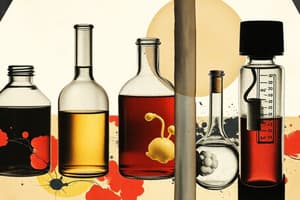Podcast
Questions and Answers
What is the principle of TLC?
What is the principle of TLC?
- The distribution of a compound between a solid phase and a liquid mobile phase (correct)
- The reaction of a compound with the reagents used for visualization
- The separation of two compounds based on their boiling points
- The interaction between a compound and the TLC plate material
What happens to a less polar compound in TLC?
What happens to a less polar compound in TLC?
- It has a weaker interaction with the silica
- It moves higher up the plate (correct)
- It stays with the mobile phase
- It has a lower Rf value
How are individual separated compounds visualized in TLC?
How are individual separated compounds visualized in TLC?
- By using reagents like Iodine, Sulfuric acid, Ninhydrin, Potassium Permagnet, Ferric chloride, UV light, etc. (correct)
- By reacting with the solvent used in TLC
- By heating the TLC plate in an oven
- Using UV light only
What is used as the solid phase in TLC?
What is used as the solid phase in TLC?
How is Rƒ (Retardation Factor) value calculated in TLC?
How is Rƒ (Retardation Factor) value calculated in TLC?
What is the main purpose of using Thin Layer Chromatography (TLC)?
What is the main purpose of using Thin Layer Chromatography (TLC)?
What is the role of the stationary phase in Thin Layer Chromatography (TLC)?
What is the role of the stationary phase in Thin Layer Chromatography (TLC)?
Which material can be used as the stationary phase in Thin Layer Chromatography (TLC)?
Which material can be used as the stationary phase in Thin Layer Chromatography (TLC)?
What is the mobile phase in Thin Layer Chromatography (TLC)?
What is the mobile phase in Thin Layer Chromatography (TLC)?
What can Thin Layer Chromatography (TLC) be used to determine?
What can Thin Layer Chromatography (TLC) be used to determine?
Flashcards are hidden until you start studying
Study Notes
Principle of TLC
- The principle of TLC is based on the difference in the partitioning behavior of the components of a mixture between the stationary phase and the mobile phase.
Separation and Visualization
- A less polar compound moves faster and farther up the TLC plate, while a more polar compound moves slower and stays closer to the starting point.
- Individual separated compounds are visualized in TLC by using a chemical reagent or by exposing the plate to iodine vapor or ultraviolet light.
Stationary Phase
- The solid phase used in TLC is usually a thin layer of silica gel or alumina on a glass plate or plastic sheet.
- The stationary phase is responsible for separating the components of a mixture based on their polarity.
Rƒ (Retardation Factor) Value
- The Rƒ value is calculated by dividing the distance traveled by the compound by the distance traveled by the solvent front.
Main Purpose of TLC
- The main purpose of using TLC is to identify, separate, and quantify the components of a mixture.
Role of Stationary Phase
- The role of the stationary phase is to separate the components of a mixture based on their polarity, allowing them to be visualized and characterized.
Stationary Phase Materials
- Silica gel, alumina, and cellulose can be used as the stationary phase in TLC.
Mobile Phase
- The mobile phase in TLC is a solvent that moves up the plate, carrying the components of the mixture with it.
Applications of TLC
- TLC can be used to determine the purity of a substance, identify the components of a mixture, and monitor the progress of a reaction.
Studying That Suits You
Use AI to generate personalized quizzes and flashcards to suit your learning preferences.




